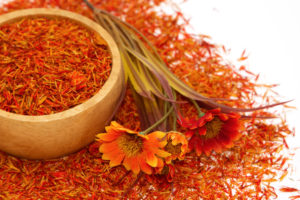Safflower (Carthamus tinctorius L.) is a highly branched, herbaceous, thistle-like annual plant. It is commercially cultivated for vegetable oil extracted from the seeds. Plants are 30 to 150 cm (12 to 59 in) tall with globular flower heads having yellow,orange, or red flowers.
Contents
Uses
Traditionally, the crop was grown for its seeds, and used for coloring and flavoring foods, in medicines, and making red (carthamin) and yellow dyes, especially before cheaper aniline dyes became available. For the last fifty years or so, the plant has been cultivated mainly for the vegetable oil extracted from its seeds.
Safflower seed oil is flavorless and colorless, and nutritionally similar to sunflower oil. It is used mainly in cosmetics and as a cooking oil, in salad dressing, and for the production of margarine. It may also be taken as a nutritional supplement. INCI nomenclature is Carthamus tinctorius.
Safflower seed is also used quite commonly as an alternative to sunflower seed in bird feeders, as squirrels do not like the taste of it.
Benefits
Safflower seed oil is used for preventing heart disease, including “hardening of the arteries” (atherosclerosis) and stroke. It is also used to treat fever, tumors, coughs,breathing problems, clotting conditions, pain, heart disease, chest pain, and traumatic injuries. Some people use it for inducing sweating; and as a laxative, stimulant, antiperspirant, and expectorant to help loosen phlegm.
Women sometimes use safflower oil for absent or painful menstrual periods; they use safflower flower to cause an abortion.
In foods, safflower seed oil is used as a cooking oil.
In manufacturing, safflower flower is used to color cosmetics and dye fabrics. Safflower seed oil is used as a paint solvent.
Cautions
Safflower seed oil is LIKELY SAFE for most people when taken by mouth.
It is POSSIBLY SAFE to take safflower flower by mouth or to inject a specific safflower oil emulsion (Liposyn) intravenously (by IV), provided the safflower oil emulsion is administered by a healthcare professional.
Special Precautions & Warnings:
Children: It is POSSIBLY SAFE to inject a specific safflower oil emulsion (Liposyn) intravenously (by IV), provided the safflower oil emulsion is administered to children by a healthcare professional.
Pregnancy and breast-feeding: Safflower seed oil is POSSIBLY SAFE to take by mouth during pregnancy. But don’t take safflower flower during pregnancy. It is LIKELY UNSAFE. It can bring on menstrual periods, make the uterus contract, and cause miscarriages.
There isn’t much information about the safety of using safflower seed oil or flower during breast-feeding. Stay on the safe side and avoid use.
Bleeding problems (hemorrhagic diseases, stomach or intestinal ulcers, or clotting disorders): Safflower can slow blood clotting. If you have any kind of bleeding problem, don’t use safflower.
Allergy to ragweed and related plants: Safflower may cause an allergic reaction in people who are sensitive to the Asteraceae/Compositae family. Members of this family include ragweed, chrysanthemums, marigolds, daisies, and many others. If you have allergies, be sure to check with your healthcare provider before taking safflower.
Diabetes: Safflower oil might increase blood sugar. There is concern that safflower oil might interfere with blood sugar control in people with diabetes.
Surgery: Since safflower might slow blood clotting, there is a concern that it could increase the risk of bleeding during and after surgery. Stop using safflower at least 2 weeks before a scheduled surgery.
Interactions
Medications that slow blood clotting (Anticoagulant / Antiplatelet drugs) interacts with SAFFLOWER
Large amounts of safflower might slow blood clotting. Taking safflower along with medications that also slow clotting might increase the chances of bruising and bleeding.
Some medications that slow blood clotting include aspirin, clopidogrel (Plavix), diclofenac (Voltaren, Cataflam, others), ibuprofen (Advil, Motrin, others), naproxen (Anaprox, Naprosyn, others), dalteparin (Fragmin), enoxaparin (Lovenox), heparin, warfarin (Coumadin), and others.
Other names
References
Source: Wikipedia, https://en.wikipedia.org/wiki/Safflower
WebMD, http://www.webmd.com/vitamins-supplements/ingredientmono-96-safflower.aspx?activeingredientid=96&

